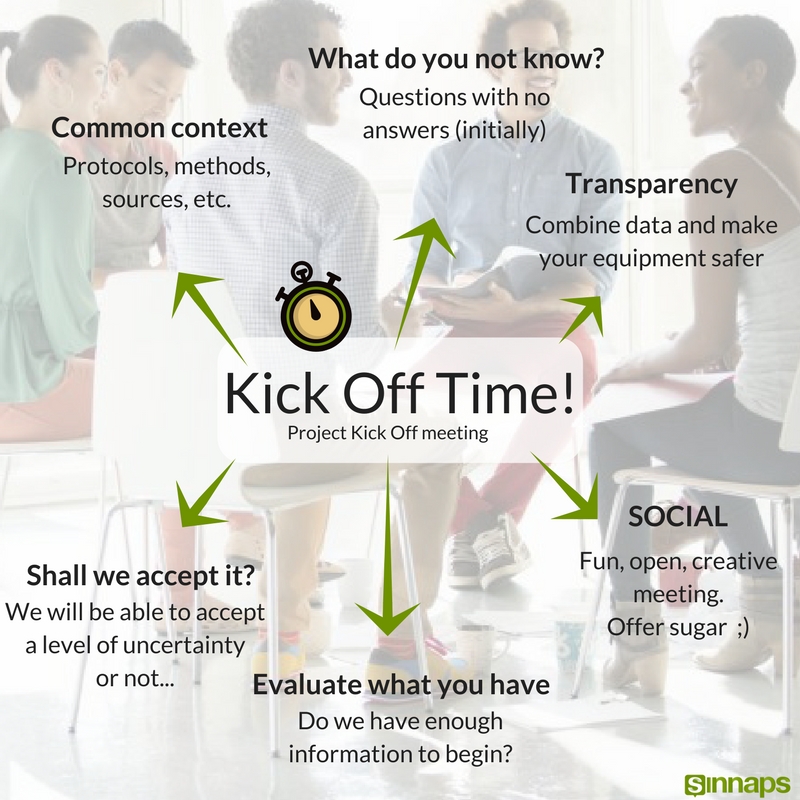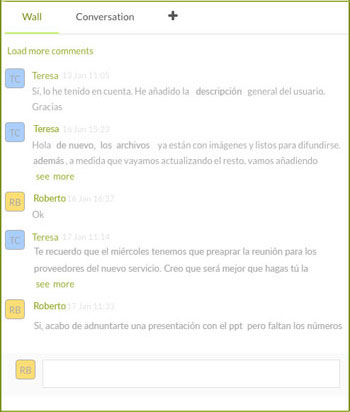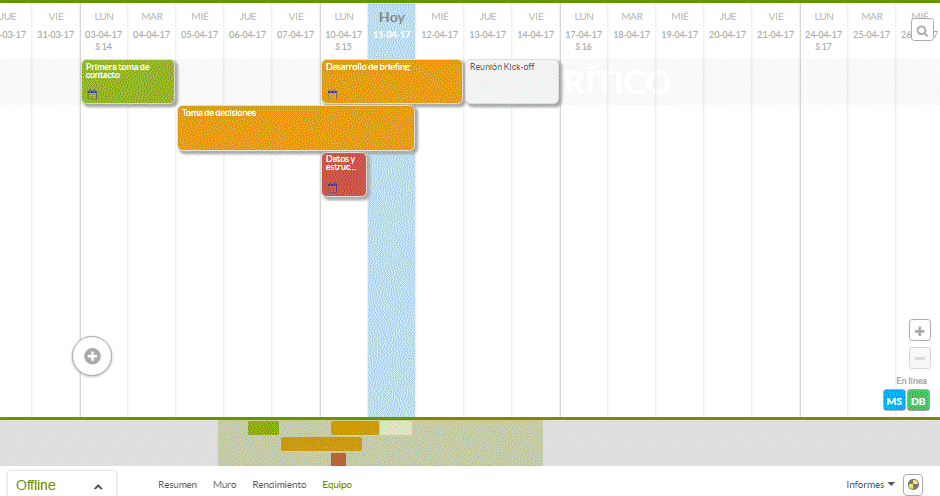Índice
- Prepare your project: A substantive kick off meeting
- STEP 01: The first thing we need to clarify is: ‘What is our starting point?’
- Step 02: Who will use our product? What for?
- STEP 03: Understand what we are facing
- STEP 04: Define the claims
- STEP 05: Explain how we are going to get what we need
- Download the template to use in your Kick Off meeting for free!
- DOWNLOAD TEMPLATE FREE
- My recommendations
- Next time…
- Questions? Don’t be shy! I will answer all of them ✌
Prepare your project: A substantive kick off meeting
There is no more important, no more profitable meeting than the Kick Off, the start of a project. However, this moment is often not granted the importance it should have. Which is a pity. Thanks to Kick off time, we can avoid loads of misunderstandings and line up many expectations. Or, in other words, save time, money and effort in achieving the company’s general objective.
At the beginning of most projects, we do not know many of the things we want to achieve. No problem: that is what the project is for – to learn. Bear in mind that the amount of information you have is inversely proportional to the uncertainty you will have to manage in your project, and most answers will remain beyond us until we have the final product.
Everything will depend on the project planning stages. In the first, what is known at the outset may be oriented towards what is covered in this lesson.

Holding a Kick Off meeting — or simply an initial presentation — helps us at different levels to:
— Create a common context for the whole team within which to pursue the project.
— Be aware of the things we do not know yet.
— Measure the level of uncertainty that we can accept at the start of each project.
— See if we have enough information to set the project in motion.
— Pool information to reduce the uncertainty of the whole team and convey confidence in the result.
— Prepare the meeting with a specific format; this will help us complete the information enabling us to establish a common methodology for all projects. Thanks to this method, we can optimise and improve matters for future projects.
As you can see, a Kick Off meeting has two key purposes: strategic and technical. However, I consider the social aspect to be more important: creating a team and providing a great tool so everyone can start working with the greatest possible amount of information.
STEP 01: The first thing we need to clarify is: ‘What is our starting point?’
To do this, it is vital to ask yourself some questions to help contextualise the product and have a point from which to start working. Here you have some of the questions that, for me personally, work to get each project ready to go in Sinnaps.
What are the main objectives of the project?
Among the general and specific project objectives, you will find the main aims to be used at Kick Off time. We should define them as clearly, measurably and SPECIFICALLY as possible. A project has different dimensions: at product level, in terms of production method, and the way in which the company works.
Try to distinguish between:
— Must Haves: things that must be achieved.
— Nice to Haves: these would be great to have as long as they are compatible with the project specifications.
It is useful not to set too many goals and never to forget the general objective of a project. Otherwise, our intentions will remain diffuse within a more complex project – adding in greater uncertainty.
What opportunity/need do we want to cover?
In order to know how to create a general project goal, you need to describe a business opportunity or need which makes our project necessary for anyone who is going to use our end product. In order to also understand it at a strategic level, try linking it to past projects and explaining it within company strategy. This question is particularly contextual and to understand why the whole project is important for the company.
How are we going to implement the results?
Explain the use to be given to the product in the short term. Everyone must be able to imagine how the work to be done will be applied. In other words, they will be able to answer many future queries. This allows us to reduce interruptions and increase work speed and team productivity.
What are the limitations on our work?
Knowing the extent of our involvement from the start simplifies everyone’s work. It is annoying when someone does something according to their criteria which is later discarded for reasons beyond our control. Or when you spend time on finding something out and are told: ‘Yeah, yeah, I knew that’. And then we think: ‘So why didn’t you say something? I’ve wasted my time for no good reason’.
These reasons mean it is necessary to define the technology to be used, be aware of the legislation that may hinder the success of the project, know which suppliers to avoid, etc. Thus, the whole team is ready for the unexpected and annoyances will be avoided.
Step 02: Who will use our product? What for?
Who is our target?
The target audience is the person, company or entity towards which our product is focused. Define it in short by trying to accumulate the data that provides a qualitative overview of your target. At this stage, you do not need a detailed definition, just a first impression.
 For example, Sinnaps is a project management tool and, in our case, we have different targets to focus on. Some of our features, such as the chat or sub-task management, are oriented towards members of the team; planning or resource management to the Project Managers (PM); and others, like the Roadmap or project portfolio, towards business managers who are tackling various projects.
For example, Sinnaps is a project management tool and, in our case, we have different targets to focus on. Some of our features, such as the chat or sub-task management, are oriented towards members of the team; planning or resource management to the Project Managers (PM); and others, like the Roadmap or project portfolio, towards business managers who are tackling various projects.
The team keeps the projects up to date. This way they provide value to the PM. The PM coordinates the project and takes decisions, controlling its progress and risks, and contributing value to the company administrator. Lastly, the company administrator is the person who decides whether or not to use Sinnaps.
As you can see, we have different targets with different functions. At this first stage, it is vital to orient our product towards each of them, as they – as a group – will be the ones who make the wheels go round. However, each of them has different needs, so we must be sure who we are addressing and when.
How is our product going to be used?
Explain the physical, time and environmental circumstances under which the project’s end product will be used. Or alternatively: under what circumstances will each of our targets be using the result of our project?
For example, if we are developing a particular service, we need to know its context. We find the answer by contemplating various scenarios or it may even be advisable to write a little story describing the situation. Just as if it were a story that you are telling someone. A lot of the information shared at this stage can be created using techniques known as Story Telling. We love stories!
What is more, we know our target, our limitations and the objectives we want to achieve. So, we use the answers to the previous questions to create different tales or stage stories in which the product will be used.
In the case of Sinnaps, the PM uses planning to simulate scenarios, which leads us to create the Test Mode. Additionally, the need for usability among those users who only need to see what needs doing and validate tasks, leads us on to the development of the activity board or Kanban board.
The creation of these stories is often highly valuable when it comes to proposing solutions, depending on the objective we want to achieve.
STEP 03: Understand what we are facing
What direct competition is out there for our product?
In this case, that means choosing our references which, again, will help us to contextualise the operational environment in which our product is developed.
To do so, gather together all the products which you want to compare with yours in terms of functionality. I don’t just mean possible ‘rivals’, but that you can also include other products or projects on which you worked. Even earlier versions, projects which covered some of the same features as your project. Refer to matters of:
— Cost
— Functionality
— Tech
— Needs to cover
Make sure you are always clear on the data to be compared. Having reached this point, now we should add quantitative information on the other products. So, do not forget to underline the final product performance using statistical and quantitative information. This way we emphasise the specific feature we want to compare with and know exactly what our Benchmark is, even what our KPI is.
It does not require much more than this. Bear in mind that we are doing this to inform the team. Do not forget that there are other tools, such as market research, if we want to go into greater detail.
STEP 04: Define the claims
To round off a good Kick Off meeting, it is important to define the Claims. Here, you can use the team to create some claims and encourage creativity and cooperation.
This is a very common practice for commercial products. However, I feel it is good to extrapolate it to project management. It helps to explain the very specific value the end result will contribute. And it can be a fun moment for the team. 🙂
A Claim is a phrase about the qualities of our product – as if it were already finished. Here are some possible examples: ‘Our new software will be the fastest on the market’; ‘The store will be cheaper than a Pound store’; or more qualitative like: ‘The new factory will be modular and adaptable’.
They do not have to be measurable or achievable aspects. They do not even have to be in line with the commercial strategy or any strategy. Their purpose at this time is to give an idea of what the PM expects to achieve. And this will help answer our questions and prioritise development activities.
If our internal claim is: ‘This product is cheaper than a Pound store’, when we are debating between two development options, we know we have to go for the one with less impact on the final price.
Another example would be if our claim is: ‘The new customer service offices will be like going into a SPA’. We can have a very clear idea about the feeling we are looking for and it will help us to find the finishes necessary.
Ensure that each of the Must Haves defined in Step 01 is represented by at least one of the claims.
STEP 05: Explain how we are going to get what we need
For this stage, it is important to have a strategic level draft plan. At this point, you do not need a detailed plan because it is not worthwhile and there may still be many unknowns.
In Sinnaps, for example, we have relatively large development projects. Each year we open up a new development project where we only define strategic features and, as we make progress, we start defining short-term actions with a maximum of three weeks. This way we can adapt to the unexpected and have a general idea of how what we are doing is going to affect things in the medium- and long term.
Think that, now, the people are only interested in knowing if you have a realistic idea of the work to be done and an approximate timeframe for when they will have to be working and on what.
It is not yet time for detailed planning. That we will see across the coming lessons in this online project management course. Preliminary planning only requires the following aspects to be considered:
— Total project duration.
— Total resources and costs.
— Stages that define more or less the general features we are going to be working on during the project.
— Main milestones and what needs to be tackled for each of them.
— The team and everyone’s responsibilities.
Equally, planning a project is something that may require weeks or even months, and it is neither necessary nor possible to have everything clear before speaking to each manager. You do not need everything laid out before you even begin. The project can start while you are specifying all the information.
If you want further information about the rules you can follow to plan a project, then read my article: 6 rules for project planning.
Download the template to use in your Kick Off meeting for free!
DOWNLOAD TEMPLATE FREE
In our case, we create an activity called Kick Off Meeting and add the team that will participate in it. When we have the sub-tasks or, in this example, the objectives done, we validate them. This is how we do it:

My recommendations
Remember that the project launch meeting has a very important social purpose. That is why I would like to give you some recommendations, based on my experience:
1/ Try to have the whole team at the meeting, and preferably in person. Do not forget that this meeting has a social purpose. Communicate. That is why we take the chance to get to know everybody – to break the ice. They are going to have to work together, so the sooner they meet the team and get to know each other, the better.
When I have worked in large teams with people I have never seen before, I have never felt like sending them questions or communicating with them. And, in the end, that affects the results of the project.
You can use social techniques or games as distractions or icebreakers, while encouraging the team’s creativity. This may seem out of place, but that is exactly the point. The sooner you get past that initial social awkwardness, the better. Don’t hesitate for a second, just go for it with humour.
I would encourage you to watch this video from Tim Brown. Really good!
The CEO at the ‘innovation and design’ firm IDEO tells us about the important link between creative thought and play. In fact, he starts playing in a conference hall. You can do some of the things, others perhaps not! The person sitting next to you will be thankful…
2/ If you can, hold the meeting away from the workplace, on neutral ground. In addition, when we leave our work environment, we tend to be more receptive and break with our pre-established work-based patterns. Lastly, by leaving the workplace, it means there will be fewer interruptions and people can focus on understanding what will be asked of them during the project.

3/ The most important thing: enough coffee and sugar!!
You want people to ask loads of questions and be proactive in the Kick off meeting. You need active brains and there's nothing better for it than coffee and sugar. You also want them to be attentive so they understand and question, so don’t go over an hour and a half without a break.
Have a 15-minute break every hour and a half and try to make everything as dynamic as possible. Don’t forget everyone thinks differently and knows far more than you. That means you might well have overlooked a few things.
The best thing that can happen is they ask questions that nobody can answer, and for that it’s essential that people aren’t bored for too long.
Every question you can’t answer is a problem you haven’t considered and a step towards reducing uncertainty.
Next time…
Next time, we will see how to plan realistically. Not all Project Managers know how to do this… Did you know that about 70% of project failures are due to unrealistic planning? In the next topic, I will explain how to tackle realistic planning and do it in the best way. It might be easier than you thought. Fear not! 😉
Questions? Don’t be shy! I will answer all of them ✌
And that’s the end of this lesson. I will update it with your feedback, so don’t hesitate send comments or contributions from your experience so other users can have their doubts dispelled.
By the way… You do not need to be a user to follow the course, but I would encourage you to try the Business account in the Sinnaps app to make your work both more productive and more effective. You will see that you can work faster and better. Use the remaining time for what you most enjoy doing!
See you next time!

Richard de Sinnaps – Let’s get things done!!
Will you help me out? 😉 If you liked this content, please share it on social networks. Thank you!!


